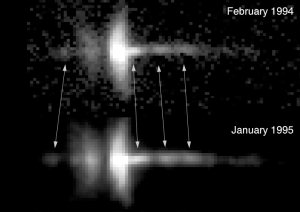

Object associated with High Velocity Molecular Gas (HVMG) near Young Stellar Objects (YSO) in star forming regions have been described in many different ways :

Associated with Young Stellar Objects (YSO) are High Velocity Molecular Gas (HVMG), Herbig-Haro (HH) objects and optical jets. The molecular gas outflows velocities are typically 5 to 20 km/s, but the optical jets and their associated Herbig-Haro objects have radial velocities up to 450 km/s with opening angles as narrow as one degree. The very high speed gas associated with the optical jets are what drive the High Velocity Molecular Gas.
The optical jet associated with the Herbig-Haro object HH34S is about 30 arcseconds long, but it terminates over a hundred arcseconds further downstream in a bow shock which resembles quasar lobes. Bow shocks and bright knots are usually associated with the end of YSO jets. Many knots shows up, (letters A through L in above figure), their outward motion has been detected in recent HST images which suggests episodic bursts from the protostar.
 |
| Radio and optical image of jet from quasar 3C 273, very similar to optical jet of HH 34S. (Bahcall et al., 1995) |
Nearly all jets aren't straight but show changes in direction or wiggles, indicating that the protostar is wobbling, perhaps from the gravitational influence of a nearby stellar companion or planetary system. This effect is plainly visible in the helical twist of the jet from quasar 3C 273. (this helical morphology is also visible in the star SS 433)
 |
HH 30 Jet EvolutionMovie of HH 30 jet motions over the span of a year reveals that the bright knots are 'spurts' from episodic bursts from the protostar (obscured by a dark band of dust between the two largest streaks). (C.Burrows, K.Stapelfeldt, A. Watson, 1995) |
 |
| HH 47 : Large scale view of bowshocks created when jets plow out a cavity in the interstellar medium about 1,500 light years away in the constellation vela near the Gum Nebula. (J. Morse/STScI, and NASA, 1995). |
There is remarkable resemblence to quasar Cygnus-A especially of the arrowhead bowshock of HH 1/2. There are nearly 300 identified Herbig-Haro objects, many more are expected to be discovered in nearby stellar nurseries. Although they have been known since the early 1950's it is only recently with the advent of infrared astronomy and the discovery of young stellar objects that their true nature has been recognized.
Rodriguez et al. (1994) have determined that about a third of these objects are detected in the radio continuum, the optical jet of the source in the HH 111 region is well aligned with a one-sided radio jet. (see also Cernicharo and Reipurth, 1996)
Recently López et al. (1995) have detected a 14 arcminute bipolar structure in planetary nebula KjPn8 using the 2.1 meter telescope at Mexico's San Pedro Mártir. The convoluted nebulosity 13 light year in size is interpreted as originating from precessing jets produced by episodic outbursts from the central star. Such collimated outflows are identical to young stellar objects and have been detected in several other planetary nebulae such as the cat's eye. The astronomers were puzzled by the presence of bright knots of shocked gas in KjPn8 which are identical to Herbig-Haro objects which are normally associated with young stellar objects, here we find them in a dying star !
Also, jet-like extensions have been found in several planetary nebula such as M2-9. (Balick, 1989; consult the last six references at the end of this page).
Jet have been detected in quasars and in many other galactic objects such as SS433, GRS 1915-105 and GRO J1655-40 which have often been referred to as 'mini-quasars'.
These recent observations of jets only emphasizes the continuity of properties common to all jet emitting objects within the galaxy.